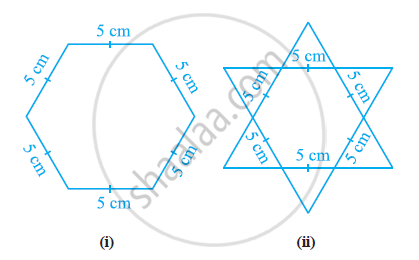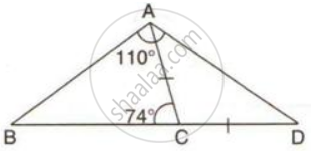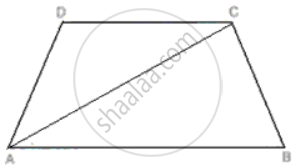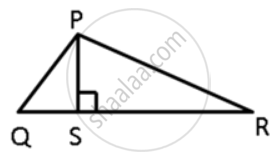Advertisements
Advertisements
Question
Arrange the sides of the following triangles in an ascending order:
ΔDEF, ∠D = 38°, ∠E = 58°.
Solution
In ΔDEF,
∠D + ∠E + ∠F = 180°
38° + 58° + ∠F = 180°
96° + ∠F = 180°
∠F = 180° - 96°
∠F = 84°
Hence, ∠D = 38°, ∠E = 58°, ∠F = 84°
38° < 58° < 84°
Hence, ascending order of the angles in the
given triangle is ∠D < ∠E < ∠F.
Hence, ascending order of sides in triangle
EF, DF, DE.
APPEARS IN
RELATED QUESTIONS
Complete the hexagonal and star shaped rangolies (see the given figures) by filling them with as many equilateral triangles of side 1 cm as you can. Count the number of triangles in each case. Which has more triangles?

In the following figure ; AC = CD; ∠BAD = 110o and ∠ACB = 74o.
Prove that: BC > CD.
Name the smallest angle in each of these triangles:
In ΔPQR, PQ = 8.3cm, QR = 5.4cm and PR = 7.2cm
Prove that the perimeter of a triangle is greater than the sum of its three medians.
D is a point on the side of the BC of ΔABC. Prove that the perimeter of ΔABC is greater than twice of AD.
ABCD is a quadrilateral in which the diagonals AC and BD intersect at O. Prove that AB + BC + CD + AD < 2(AC + BC).
ABCD is a trapezium. Prove that:
CD + DA + AB + BC > 2AC.
In ΔPQR, PS ⊥ QR ; prove that: PQ > QS and PQ > PS
In ΔPQR is a triangle and S is any point in its interior. Prove that SQ + SR < PQ + PR.
Prove that in an isosceles triangle any of its equal sides is greater than the straight line joining the vertex to any point on the base of the triangle.
